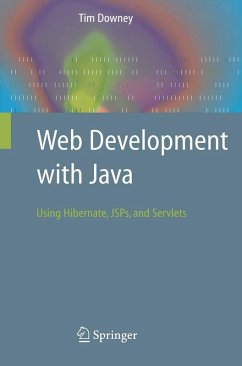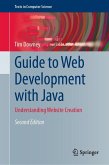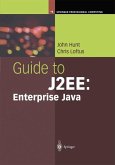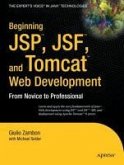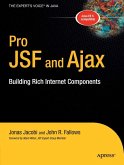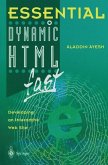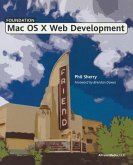Web development is simpler than it seems, especially with the software tools freely available on the Web. This book breaks from the tradition of teaching a history of Web development and jumps to the good stuff from the outset so that students can start writing real applications.
This comprehensive textbook introduces readers to the three-tiered, Model-View-Controller architecture by using Hibernate, JSPs, and Java Servlets. These three technologies all use Java, so that a student with a background in programming will be able to master them with ease, with the end result of being able to create web applications that use MVC, validate user input and save data to a database.
Features and topics:
. Presents the many topics of web development in small steps, in an accessible, easy-to-follow style; focusing on the most important information first, and allowing the reader to gain basic understanding before moving forwards
. Uses existing powerful technologies that are freely available on the web to speed up web development, such as JSP, JavaBeans, Annotations, JSTL, Java 1.5, Hibernate and Tomcat
. Starts with the simplest technology for web development (JSP) and gradually introduces the reader to more complex topics
. Core technologies are introduced from the outset, such as the Model-View-Controller architecture
. Includes many helpful pedagogical tools for students and lecturers such as, an introduction to each topic, questions and exercises at the end of each chapter, detailed illustrations and chapter summaries
. By using Hibernate as the database tool in this book, there is no need for the reader to know SQL
Written for novice developers with a solid background in programming, but who do not have any database training, this thorough, easy-to-use book provides an exemplary introductory course in web development for undergraduates, as well as web developers. With its straightforward and systematic style this text is also ideal for self-study.
Tim Downey has over ten years experience teaching web development, and has won Outstanding Teaching Awards in 1997, 2002, 2006 and 2007. He maintains the following active website which contains many complete examples and tutorials: http://www.bytesizebook.com/
This comprehensive textbook introduces readers to the three-tiered, Model-View-Controller architecture by using Hibernate, JSPs, and Java Servlets. These three technologies all use Java, so that a student with a background in programming will be able to master them with ease, with the end result of being able to create web applications that use MVC, validate user input and save data to a database.
Features and topics:
. Presents the many topics of web development in small steps, in an accessible, easy-to-follow style; focusing on the most important information first, and allowing the reader to gain basic understanding before moving forwards
. Uses existing powerful technologies that are freely available on the web to speed up web development, such as JSP, JavaBeans, Annotations, JSTL, Java 1.5, Hibernate and Tomcat
. Starts with the simplest technology for web development (JSP) and gradually introduces the reader to more complex topics
. Core technologies are introduced from the outset, such as the Model-View-Controller architecture
. Includes many helpful pedagogical tools for students and lecturers such as, an introduction to each topic, questions and exercises at the end of each chapter, detailed illustrations and chapter summaries
. By using Hibernate as the database tool in this book, there is no need for the reader to know SQL
Written for novice developers with a solid background in programming, but who do not have any database training, this thorough, easy-to-use book provides an exemplary introductory course in web development for undergraduates, as well as web developers. With its straightforward and systematic style this text is also ideal for self-study.
Tim Downey has over ten years experience teaching web development, and has won Outstanding Teaching Awards in 1997, 2002, 2006 and 2007. He maintains the following active website which contains many complete examples and tutorials: http://www.bytesizebook.com/
Dieser Download kann aus rechtlichen Gründen nur mit Rechnungsadresse in A, B, BG, CY, CZ, D, DK, EW, E, FIN, F, GR, HR, H, IRL, I, LT, L, LR, M, NL, PL, P, R, S, SLO, SK ausgeliefert werden.
From the reviews:
"Downey summarizes ... clearly and succinctly, the focus of the book: Java servlets that use JavaServer Pages (JSP) and connect to a MySQL database using the Hibernate framework. The book covers precisely what the title says. ... At the end of the book, there is a one-page glossary of terms; a one-page list of additional resources, books, and Web sites; and a detailed eight-page index ... . In conclusion, I strongly recommend this book to readers who are interested in developing component-based systems ... ." (M. M. Tanik, Computing Reviews, December, 2008)
"Downey summarizes ... clearly and succinctly, the focus of the book: Java servlets that use JavaServer Pages (JSP) and connect to a MySQL database using the Hibernate framework. The book covers precisely what the title says. ... At the end of the book, there is a one-page glossary of terms; a one-page list of additional resources, books, and Web sites; and a detailed eight-page index ... . In conclusion, I strongly recommend this book to readers who are interested in developing component-based systems ... ." (M. M. Tanik, Computing Reviews, December, 2008)

